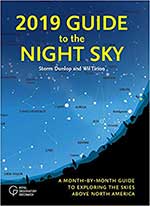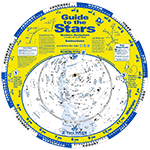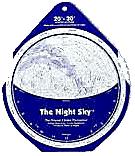|
1
|
Moon near Venus (47° from Sun, morning sky) at 22h UT. Mag. −4.5.
|
|
3
|
Earth at Perihelion (closest to Sun) at 5h UT. The Sun-Earth distance is 0.983301 a.u. or 147.1 million kilometers.
• Sun at Aphelion and Perihelion (Anthony Ayiomamitis)
|
|
3
|
Moon near Jupiter (morning sky) at 8h UT. Mag. −1.8.
|
|
4
|
Quadrantid Meteor Shower peaks at 2h UT. Active between December 28 and January 12. Produces up to 120 meteors per hour. Radiant is in northern Boötes.
• Quadrantids (Wikipedia)
• 2019 Meteor Shower Calendar (PDF) (IMO)
|
|
6
|
New Moon at 1:28 UT. Start of lunation 1188.
• Lunation Number (Wikipedia)
|
|
6
|
Partial Eclipse of the Sun at 1:41 UT (greatest). Visible from NE Asia and north Pacific. Begins at 23:34 (Jan 5) and ends at 3:49 UT.
• Solar Eclipses: 2011 - 2030 (Mr Eclipse)
• NASA Solar Eclipse Page (NASA)
• Partial Solar Eclipse of 2019 January 6 (GIF) (NASA)
|
|
6
|
Venus at greatest elongation west (47° from Sun, morning sky) at 5h UT. Mag. −4.4.
|
|
9
|
Moon at apogee (farthest from Earth) at 4h UT (distance 406,117 km; angular size 29.4').
|
|
13
|
Moon near Mars (evening sky) at 1h UT. Mag. 0.6.
• Mars (Wikipedia)
|
|
14
|
First Quarter Moon at 6:45 UT.
|
|
16
|
Venus 7.8° N of Antares (47° from Sun, morning sky) at 23h UT. Mags. −4.4 and 1.1. Jupiter nearby.
|
|
17
|
Moon near the Pleiades (evening sky) at 1h UT.
• The Pleiades (Wikipedia)
|
|
17
|
Moon near Aldebaran (evening sky) at 19h UT.
• Aldebaran (Wikipedia)
|
|
21
|
Total Eclipse of the Moon begins at 4:41 UT and ends at 5:43 UT. Mid-eclipse at 5:13 UT. Partial phases begin at 3:34 UT and end at 6:51 UT. Moon appears red-orange in color during totality (the color of Earth's sunsets). Visible from central Pacific, North and South America, Europe, and Africa.
• Lunar Eclipses: 2011 - 2030 (Mr Eclipse)
• NASA Lunar Eclipse Page (NASA)
• Total Lunar Eclipse of 2019 January 21 (PDF) (NASA)
|
|
21
|
Full Moon at 5:16 UT.
• Full Moon Names (Wikipedia)
|
|
21
|
Moon at perigee (closest to Earth) at 20:00 UT (357,342 km; angular size 33.4').
|
|
22
|
Venus 2.4° N of Jupiter (46° from Sun, morning sky) at 16h UT. Mags. −4.3 and −1.8. A spectacular sight over several days.
|
|
23
|
Moon near Regulus (morning sky) at 4h UT.
• Regulus (Wikipedia)
|
|
26
|
Moon near Spica (morning sky) at 21h UT.
|
|
27
|
Last Quarter Moon at 21:11 UT.
|
|
31
|
Moon near Jupiter (53° from Sun, morning sky) at 2h UT. Mag. −1.9.
|
|
31
|
Moon near Venus (45° from Sun, morning sky) at 17h UT. Mag. −4.3. Spectacular occultation visible from w South America and Polynesia.
• Venus (Wikipedia)
• Occultation of Venus (IOTA)
|
|
|
|
All times Universal Time (UT).
- USA Eastern Standard Time = UT − 5 hours.
- Australian Eastern Summer Time = UT + 11 hours
- Singapore Standard Time = UT + 8 hours.
|



